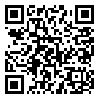Volume 7, Issue 1 (Spring 2004)
J Arak Uni Med Sci 2004, 7(1): 15-25 |
Back to browse issues page
Download citation:
BibTeX | RIS | EndNote | Medlars | ProCite | Reference Manager | RefWorks
Send citation to:



BibTeX | RIS | EndNote | Medlars | ProCite | Reference Manager | RefWorks
Send citation to:
Bayat A, Maleki M, Akbari M, Salehi R. Tracking Hearing Damage Caused by Noise Using the Phone's Sound Beam Test. J Arak Uni Med Sci 2004; 7 (1) :15-25
URL: http://jams.arakmu.ac.ir/article-1-6777-en.html
URL: http://jams.arakmu.ac.ir/article-1-6777-en.html
Abstract: (3268 Views)
Introduction: The phone's sound beams are known to be a valid test that reflects the activity of foreign hair cells, and are therefore very useful for assessing cochlear changes, such as those that occur after exposure to noise.
method: In one clinical trial, 74 volunteers aged 18-25 were examined by simple random sampling. The results of audiometric tests of the participants' pure sounds and tympanometry were within the norm on the day of the experiment. In this study, the phonetic tests of the phone were spontaneous, transient, and distorted from both ears of the subject, which was considered as a basic level of evaluation for us. Then a person's ear was selected and in the intensity of SPL 100 decibels and for 5 minutes in his ear was given a turn. After 2 minutes after the end of the presentation, the previous evaluations were repeated in both ears and the range of responses in both ears was compared.
Results: In 34 participants, submucosal nostrils led to a decrease in amplitude or SOAE responses. One of the interesting findings in this study was the emergence of new peaks in SOAE responses in the opposite ear after the presentation of the sound. The proposed noise created a significant statistical decrease in the range of TEOAE response both in the affected ear and in the opposite ear. Comparing the mean amplitude of DPOAE responses before and after exposure to shift-induced noise in the ear was significant in the Hertz range of 1699-6299, but this comparison was not significant in the opposite ear. The mean time of DPOAE incubation before and after exposure to shingles did not show a statistically significant difference in both the affected ear and the opposite ear.
Conclusion: The findings show that the phone's sound beams are a good tool for tracking hearing damage caused by noise. TEOAEs are also more sensitive to tracking than other tests, and can even be used as a very fast screening tool to assess susceptibility to hearing damage caused by noise before entering high-end industrial environments. And considered sound.
method: In one clinical trial, 74 volunteers aged 18-25 were examined by simple random sampling. The results of audiometric tests of the participants' pure sounds and tympanometry were within the norm on the day of the experiment. In this study, the phonetic tests of the phone were spontaneous, transient, and distorted from both ears of the subject, which was considered as a basic level of evaluation for us. Then a person's ear was selected and in the intensity of SPL 100 decibels and for 5 minutes in his ear was given a turn. After 2 minutes after the end of the presentation, the previous evaluations were repeated in both ears and the range of responses in both ears was compared.
Results: In 34 participants, submucosal nostrils led to a decrease in amplitude or SOAE responses. One of the interesting findings in this study was the emergence of new peaks in SOAE responses in the opposite ear after the presentation of the sound. The proposed noise created a significant statistical decrease in the range of TEOAE response both in the affected ear and in the opposite ear. Comparing the mean amplitude of DPOAE responses before and after exposure to shift-induced noise in the ear was significant in the Hertz range of 1699-6299, but this comparison was not significant in the opposite ear. The mean time of DPOAE incubation before and after exposure to shingles did not show a statistically significant difference in both the affected ear and the opposite ear.
Conclusion: The findings show that the phone's sound beams are a good tool for tracking hearing damage caused by noise. TEOAEs are also more sensitive to tracking than other tests, and can even be used as a very fast screening tool to assess susceptibility to hearing damage caused by noise before entering high-end industrial environments. And considered sound.
Keywords: A Quick Phone Sound Beams, Beams Phone Voice Distortion, Beams Phone Sound Spontaneous, Hearing Loss Caused by Noise
Type of Study: Original Atricle |
Subject:
Basic Sciences
Received: 2021/01/27 | Accepted: 2004/03/29
Received: 2021/01/27 | Accepted: 2004/03/29
| Rights and permissions | |
 |
This work is licensed under a Creative Commons Attribution-NonCommercial 4.0 International License. |





